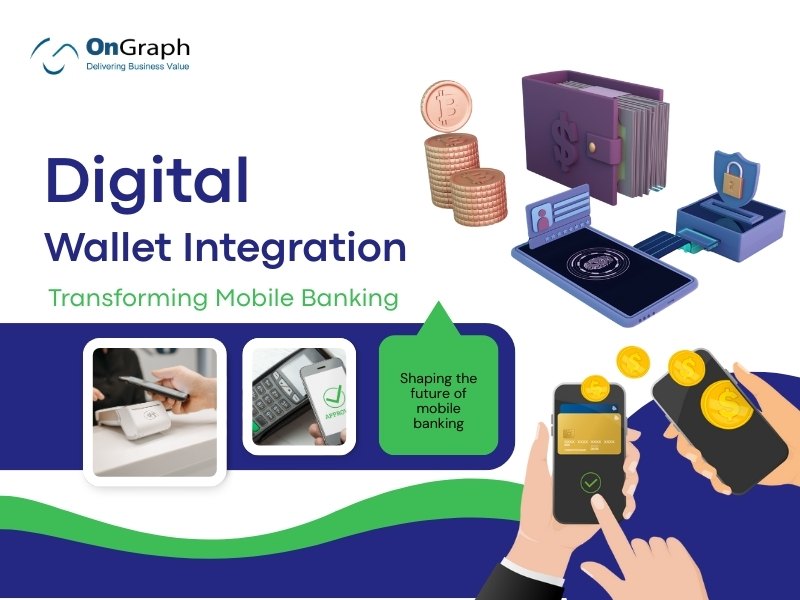In this article
- Market Outlook: The Rise of Digital Wallets
- Benefits of Digital Wallet Integration in Mobile Banking
- Real-World Example: Apple Pay & Google Pay Integration
- Role of Digital Transformation Services
- How Digital Wallet Integration Works?
- The Role of Cryptocurrency and Blockchain
- Security: The Cornerstone of Wallet Integration
- Case Study: A Regional Bank’s Transformation
- Why Wallet Integration Is the Future?
- Conclusion
In the last decade, mobile banking has transformed from a convenience into a necessity. Today’s customers expect faster, safer, and more seamless digital payment experiences. This is where Digital Wallet Integration becomes critical. By embedding wallet functionality into banking and fintech apps, financial institutions can deliver secure, contactless, and highly convenient services that match evolving customer expectations.
From tap-and-pay NFC transactions to managing cryptocurrency assets, wallet integration is redefining how people interact with money. Let’s explore why it is set to become the future of mobile banking.
Market Outlook: The Rise of Digital Wallets
- According to Statista, the global digital payments market is expected to reach $16.6 trillion by 2028, growing at a CAGR of 12.2%.
- A 2024 McKinsey report found that two-thirds of global consumers now prefer digital wallets over cash or card payments.
- In Australia, the Reserve Bank reported that 75% of in-person payments in 2024 were contactless, largely driven by NFC wallet technology.
Clearly, the adoption curve is only moving upward, making mobile banking app development with wallet features a strategic necessity.
Benefits of Digital Wallet Integration in Mobile Banking
1. Seamless Customer Experience
With wallet integration, users can store payment cards, IDs, and even transit passes within their banking app. This eliminates the need for physical wallets while offering a frictionless payment journey.
2. Secure Banking Solutions
Modern wallets use tokenization, biometric authentication, and encryption to protect sensitive data. By integrating wallets, banks offer secure banking solutions that boost customer trust and minimize fraud risks.
3. Wider Payment Options
From credit/debit cards to UPI, QR codes, and even cryptocurrencies, a digital wallet integration platform supports multiple payment methods under one umbrella.
4. Customer Loyalty and Engagement
Banks can offer loyalty points, cashback, or personalized offers directly within the digital wallet, strengthening customer relationships.
Real-World Example: Apple Pay & Google Pay Integration
When global banks integrated Apple Pay and Google Pay into their apps, adoption skyrocketed. In the U.S., Apple Pay accounted for 13% of in-store transactions in 2024 (Insider Intelligence). This shows how wallet integration isn’t just a trend—it’s a customer demand that drives revenue.
Role of Digital Transformation Services
For banks and fintech startups, implementing digital wallets is part of a broader modernization strategy. Partnering with a digital transformation company allows them to:
- Modernize legacy banking systems
- Ensure compliance with global security standards (PCI DSS, GDPR, etc.)
- Create a scalable architecture for future innovations
In short, wallet integration is not a standalone feature—it’s an essential step in a bank’s digital transformation services journey.
Ready to launch your mobile wallet app? Let’s build it together.
From secure payments to seamless integration, we’ll build a future-ready app tailored to your business.
How Digital Wallet Integration Works?
1- User Authentication – Biometric (fingerprint, face recognition) or PIN-based login.
2- Card & Account Linking – Storing card credentials securely through tokenization.
3- Payment Execution – Contactless (NFC), QR-based, or in-app checkout.
4- Transaction Validation – Real-time verification via banking APIs.
5- Data Analytics – Capturing transaction insights for personalization.
This integration ensures that banking apps evolve into digital wallet integration platforms capable of handling everything from daily purchases to complex financial services.
The Role of Cryptocurrency and Blockchain
The next evolution of mobile banking will merge traditional wallets with crypto wallet functionality. However, development costs are a concern.
- The average crypto wallet app development cost ranges from $40,000 to $150,000, depending on features like multi-currency support, blockchain integration, and advanced security protocols.
Forward-thinking banks are already exploring hybrid wallets that handle both fiat and crypto transactions, creating new opportunities in the financial services ecosystem.
Security: The Cornerstone of Wallet Integration
Security is non-negotiable in digital banking. Key safeguards include:
- Tokenization – Replacing card details with secure tokens.
- End-to-End Encryption – Protecting sensitive transaction data.
- Multi-Factor Authentication – Combining biometrics with OTPs.
- Fraud Detection Systems – Using analytics and AI to spot anomalies.
By embedding these measures, banks deliver secure banking solutions that meet regulatory demands and win customer confidence.
Case Study: A Regional Bank’s Transformation
In 2024, a mid-sized European bank partnered with a digital transformation company to embed wallet functionality into its mobile banking app. Within six months:
- Digital transactions grew by 35%
- Customer app engagement rose by 28%
- Cashless payments increased significantly in younger demographics
This shows the tangible impact of digital wallet integration on customer behavior and revenue growth.
Why Wallet Integration Is the Future?
- Consumer Demand: Customers expect one-tap payments and mobile-first banking.
- Competitive Advantage: Banks without wallet features risk losing customers to fintech startups.
- Innovation Gateway: Wallets serve as the foundation for value-added services like buy-now-pay-later (BNPL), loyalty programs, and cryptocurrency transactions.
In short, wallet integration isn’t just a feature—it’s the future of mobile banking app development.
Conclusion
Digital Wallet Integration is no longer optional for banks and fintechs—it’s essential. By embedding wallets, financial institutions deliver secure, seamless, and modern banking experiences that meet customer expectations and industry trends.
Partnering with a reliable digital transformation company or leveraging professional digital transformation services ensures that wallet projects are implemented with the right blend of security, scalability, and innovation. As the world moves toward contactless and cashless societies, wallet integration will be the key driver of secure banking solutions and long-term customer loyalty.
FAQs
Digital Wallet Integration means embedding wallet features (like payments, card storage, loyalty rewards, or crypto support) into a mobile banking app. It allows users to make contactless payments, store digital cards, and access multiple financial services in one secure platform.
Banks benefit from wallet integration because it improves customer experience, boosts loyalty, and supports contactless, secure payments. With rising global demand for mobile-first banking, it has become a critical step in digital transformation.
A wallet integration platform connects payment gateways, banking APIs, and security protocols. It enables users to link their cards/accounts, make NFC or QR payments, and manage transactions within the app while ensuring encryption and compliance with financial regulations.
Digital transformation services help banks modernize legacy systems, integrate wallets securely, and ensure compliance with global standards. Partnering with a digital transformation company ensures scalability, faster development, and smooth user adoption.
The crypto wallet app development cost typically ranges from $40,000 to $150,000 depending on features like multi-currency support, blockchain integration, and advanced security. Adding crypto features into a banking wallet increases overall development costs.
Yes. Wallet integration uses advanced measures like tokenization, biometric authentication, and fraud detection systems. These ensure secure banking solutions, protecting user data and transactions from cyber threats.
Digital wallets will shape mobile banking by enabling contactless payments, cryptocurrency support, loyalty programs, and faster transactions. As customers increasingly prefer cashless solutions, wallet integration will become the standard in modern banking apps.
About the Author
Let’s Create Something Great Together!
Latest Blog
















